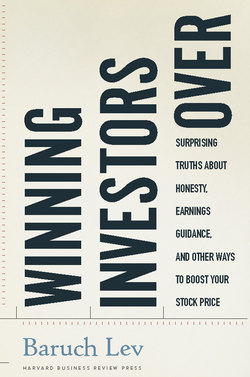Читать книгу Winning Investors Over - Baruch Lev - Страница 39
На сайте Литреса книга снята с продажи.
Crime and Punishment
ОглавлениеAnd what about the perpetrators of reporting manipulations? Jonathan Karpoff, Scott Lee, and Gerald Martin examined all the SEC and Department of Justice (DOJ) enforcement actions for financial misrepresentations from 1977 to 2006, in all 788 actions, documenting the fate of persons targeted by these actions: 2,206 employees of the companies involved, 723 of whom were CEOs, presidents, or board chairs.44 The turnover rate of these corporate chiefs should give a long pause to any manager contemplating cooking the books. Almost 80 percent of the targeted executives left or were terminated before the public announcement of the SEC or DOJ action, and an additional 11 percent were dismissed by the end of the regulatory proceedings.45 The turnover rate was even higher (96 percent) for the nonexecutives targeted by the SEC or DOJ (it’s easier to dump those without golden parachutes). Thus, the likelihood of survival for an executive or employee targeted by an enforcement action is even slimmer than Evel Knievel’s chance of motorcycle jumping over fourteen Greyhound buses (he actually made it on October 25, 1975, in Kings Island, Ohio).
But losing one’s job is by no means the end of travails. The SEC initiated civil litigation against 87 percent of the 723 CEOs, presidents, and board chairs, resulting in a third of them barred from serving as officers or directors of public companies and a quarter being criminally indicted, 102 of whom were sentenced to an average of 5.7 years in prison. On top of all this, most of the targeted executives paid substantial fines. Even more bad news for perpetrators: the prosecutorial zeal and severity of punishment increased substantially in the wake of the early-2000s accounting scandals and the Sarbanes-Oxley Act. Justice Department data indicates that, between July 2002 and March 2006, there have been more than 1,000 convictions (including plea bargains) in corporate-fraud cases, including 82 CEOs, 85 presidents, 36 CFOs, and 102 vice presidents.46 Pretty scary stuff.
Trying to see the bright side, you may ask, what about all the undetected and unpunished manipulations? Don’t shareholders of these firms enjoy higher stock prices and managers richer compensation? In some cases, they do, when the business slowdown triggering the manipulation is temporary, and a quick recovery allows managers to “mend their ways” with nobody the wiser. But, one rarely knows ahead of time the duration of a slowdown, so that embarking on a manipulation gets you on a very risky path. And even if the manipulation somehow escapes exposure, the potpourri of SEC enforcement actions discussed earlier indicates that most manipulations adversely affect business operations. Thus, Gateway achieved its revenue targets by selling computers to previously rejected, poor-credit customers, essentially at a loss. Coca-Cola’s gallon-pushing program was enabled by a significant extension of credit to bottlers, “typically … from eight to twenty-eight or thirty days,” increasing Coke’s cost of funds. Charter Communications, striving to portray solid customer growth, continued to provide costly services to delinquent customers as well as to those who asked to be disconnected, obviously with no revenues to match. Daisytek’s large acquisitions of slow-moving, obsolete inventories ultimately drove it to bankruptcy. And i2 Technologies’ front-loading of revenues was costly too, as the SEC notes: “To close certain sales, i2 sales representatives exaggerated or oversold what certain software products could actually do. After these deals closed, i2 technicians were, in many instances, able to write code to create the promised functionality, but these efforts took much time, effort and expense … and i2’s relationship with some customers had been strained, due in part to the substantial post-license work i2 had to perform to make its software deliver what had been agreed upon” (emphasis mine).47 And don’t forget the taxes—actual cash outflows—paid on the inflated earnings.
These substantial costs of the SEC-sanctioned cases are clearly also present in manipulations that don’t see the light of day. Add to this the costs of needless investment and recruiting to portray an image of success, documented by Kedia and Philippon,48 and the loss from postponement or cancelation of R & D, advertising, or maintenance to make the numbers, and the weighty burden of information manipulation, detected or not, becomes clear. Obviously, there is no free lunch in information manipulation.
